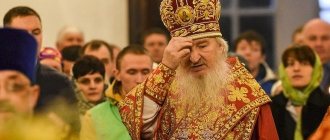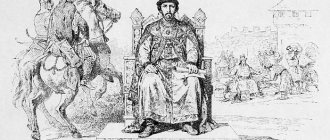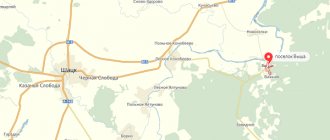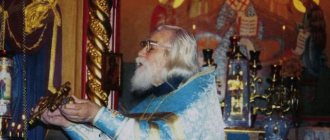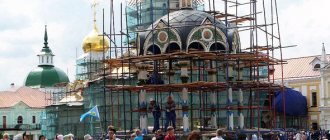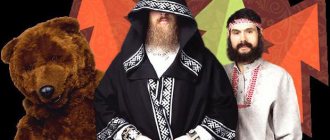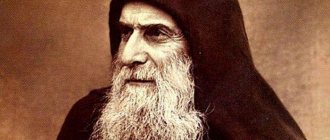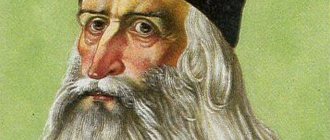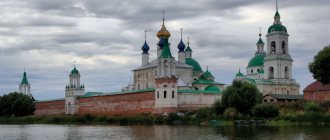| Archbishop Gabriel (Steblyuchenko) |
Gabriel (Steblyuchenko)
(1940 - 2016), Archbishop b. Ust-Kamenogorsk and Semipalatinsk In the world Steblyuchenko Yuri Grigorievich, was born on June 30, 1940 in the city of Kherson, in the Ukrainian SSR, into a worker-peasant family.
In 1958, after graduating from high school, he entered the Odessa Theological Seminary and at the same time became a novice at the Odessa Dormition Monastery.
In 1959, he was tonsured a monk and named in honor of the Great Martyr George the Victorious.
In 1962 he entered the Leningrad Theological Academy, from which he graduated in 1966 with a candidate of theology degree for his work “ Relationships of the Russian and Anglican Churches in the light of historical literature”
«.
On June 15, 1966, he was tonsured a monk and named in honor of the Archangel Gabriel by Metropolitan Nikodim (Rotov) of Leningrad, and on June 19 of the same year he was ordained a hierodeacon and assigned to serve in the city of Vyborg, Leningrad Region.
In 1966, he was a participant in the Christian Peace Youth Conference, which was held in Kuopio, Finland.
From January 20, 1967 [1] to August 15, 1968, he was secretary of the Russian Ecclesiastical Mission in Jerusalem in the rank of archdeacon.
| Hieromonk Gabriel (Steblyuchenko), rector of the Transfiguration Cathedral in Vyborg, 1969 |
In 1968, at the end of a business trip abroad, he was ordained hieromonk by Metropolitan Nikodim (Rotov) of Leningrad and appointed rector of the Vyborg Transfiguration Cathedral.
On January 22, 1972, he was transferred to the Pskov diocese and appointed rector of the Trinity Cathedral in the city of Pskov and at the same time the responsible representative of the Pskov Metropolitan for welcoming foreign guests.
On April 7, 1974 he was elevated to the rank of abbot.
On April 7, 1975, he was appointed abbot of the Pskov-Pechersky Monastery in the city of Pechory, Pskov Region, with elevation to the rank of archimandrite.
“There were many complaints about his activities.
The monks, who held Gabriel responsible for the fatal incidents that occurred in the monastery, filed a complaint with Patriarch Pimen. Although the Patriarch removed Archimandrite Gabriel from his post, he was restored to it by the Deputy Chairman of the Council for Religious Affairs V. Furov, who specially came to the monastery” [2].
On July 19, 1988, he was elected Bishop of Khabarovsk and Vladivostok by the Holy Synod of the Russian Orthodox Church. The episcopal consecration took place on July 23 of the same year.
On January 31, 1991, he was temporarily removed from the management of the diocese by the Holy Synod “due to numerous complaints regarding the management of the diocese and moral character”
.
A synodal commission was appointed to investigate. On March 25 of the same year, he was found guilty, by the definition of the Holy Synod, “of violating the episcopal oath, expressed in accepting a banned clergyman of another diocese and granting him the right to officiate (Ap. 16), of violating church peace and an unworthy despotic attitude towards the clergy and laity ( Ap. 27, Dvukr. 9), in the lack of concern for the organization of diocesan and parish life (Ap. 36), in exceeding the powers of the ruling bishop, expressed in awarding his clergy with patriarchal church awards, in behavior discrediting the high title of bishop
. By a synodal decision, he was dismissed from the staff, banned from the priesthood for three years and sent for “prayer and complete repentance” to the Pskov-Pechersky Monastery under the supervision of a local bishop [3].
On July 18, 1991, by synodal decision, he was transferred to the Konevsky Mother of God-Nativity Monastery.
On April 21, 1994, he was appointed ruling bishop of the newly formed Blagoveshchensk and Tynda diocese.
He was a participant in the winter session of the Holy Synod of the Russian Orthodox Church in 2001-2002 [4].
On February 25, 2003, he was elevated to the rank of archbishop.
On October 5, 2011, he was transferred to the newly formed Ust-Kamenogorsk department. He did not arrive in the Ust-Kamenogorsk diocese [5].
On December 27, 2011, he was retired for health reasons in accordance with the submitted petition [6].
He died at about half past one on the night of May 20, 2016 in a hospital in the city of Blagoveshchensk, Amur Region, at the age of 76, after a serious illness from a stroke [7]. On May 22 of the same year, a funeral service took place, which was led by Bishop Lukian (Kutsenko) of the Annunciation Cathedral in the city of Blagoveshchensk, co-served by numerous clergy. He was buried, according to his will, at the altar of the same cathedral [8].
Name day - July 13 (July 26 new style).
Awards
Church:
- Gaiter (1968)
- pectoral cross (August 19, 1971)
- Mace (April 7, 1974)
- Order of the Holy Apostles Peter and Paul, Antiochian Orthodox Church (1974)
- Order of Saint Equal-to-the-Apostles Prince Vladimir, III degree (1975)
- Order of St. Sergius of Radonezh, III degree (1980)
- Order of the Holy Blessed Prince Daniel of Moscow, II degree (1990)
- Order of St. Innocent, III degree (2000)
- Order of St. Seraphim of Sarov II degree (2005)
- commemorative medal “1020th anniversary of the Baptism of Rus'” (2008)
- Medal of Saint Equal-to-the-Apostles Prince Vladimir (2015)
Secular:
- honorary medal of the All-Russian Society for the Protection of Historical and Cultural Monuments (1986)
- Medal of Honor “For Peace Fighter” (1988)
- gold medal of the Soviet Peace Foundation (1990)
- State Order of Honor (No. 9965 dated August 11, 2000)
- honorary medal “For sacrificial service” from the Orthodox social movement “Orthodox Russia” (2001)
- badge “For Space Exploration” (2002, No. 115)
- medal “Alexy - a man of God” from the Union of Russian Cossacks (2001, No. 56)
- badge “200 years of the Ministry of Internal Affairs of Russia” (2002, No. 706)
Archimandrite Filaret (Koltsov):
The first time I came to the Pskov-Pechersky Monastery was in 1975, in August, on the eve of the patronal feast of our monastery - the Dormition of the Blessed Virgin Mary. I came from a provincial town, and the monastery struck me first of all with its beauty. At that time I still understood little about monasticism, I knew nothing about the elders, but the spirit of Pechora itself gave birth to a special state: all the monks were saints for me then. In 1976, I entered the ranks of the brethren, I was received here by the now deceased viceroy, Archbishop Gabriel (Steblyuchenko) - “the thunderstorm of all peoples, seas and oceans.” Unfortunately, I did not find Father Alypiy (Voronov), but I am very grateful to Father Gabriel, I remember him and pray for him as best I can...
Of course, there were elders here. True, I no longer saw the Valaam fathers who had previously labored in Pechory, but I still saw this flower of monasticism and eldership. At first I recognized schema-hegumen Savva (Ostapenko), then Father John (Krestyankin).
Father John for me, I think, as for everyone, is a vessel of grace through which the grace of God is poured onto us. His love for God and for people was amazing: no matter who came to him, he would accept everyone, caress, kiss, hug, give gifts, and, of course, spiritually instruct. Everyone came with their own problems. At that time there were no more severe persecutions, but, nevertheless, the state was atheistic. Father John tried to console everyone, and indeed, no one left him unconsoled.
All our elders for me were the guardians of the faith, the guardians of the spirit of monasticism. Father John said about his generation: “We are from Nicholas,” because he was born in Orthodox Imperial Russia and absorbed this spirit; I didn’t waste it, having gone through all the tests of that time, but saved it and passed it on to us. Of course, it all started in childhood, because in Orel he was already a sexton from the age of six, and at the age of 12 he served as subdeacon with Archbishop Seraphim (Ostroumov), Bishop Nikolai (Nikolsky), now glorified by the Church. A twelve-year-old boy asked Bishop Nicholas for a blessing to become a monk - a serious statement, that’s where this spirit comes from! The Bishop, blessing, said: “You will finish school, then you will work, you will be ordained, and then you will be a monk.” This was a whole program for Father John, and in principle that’s how it all happened. All his life, Father John kept a photograph of the bishops, given to him at that time and signed by Archbishop Seraphim: “From two friends in the Lord to a young friend Vanya, with prayer. May the Lord fulfill the desire of your heart and give you true happiness in life.” The saints, new martyrs and confessors of the Russian Church called him, at thirteen years old, a friend, and he justified this with his whole life.
Father John showed us the spiritual beauty that he inherited from his mentors. His confessor was Abbot John (Sokolov), the last Elder of Optina, whom Father John greatly revered and called “professor of the Heavenly Academy.” He greatly appreciated and honored Elder Sebastian of Karaganda. And when Father John returned from prison in 1955, he went to the Glinsk hermitage, and Schema-Archimandrite Seraphim (Romantsov) became his confessor, who a few years later, already in Sukhumi, tonsured Father John as a monk, giving him a name in honor of the apostle during tonsure Love of the Evangelist John the Theologian. Father John lived his entire life in chastity, in purity, even his cell was all decorated in white - for me this is an image of his inner holiness, his chastity. We are living witnesses of this holiness.
Of course, he had a special gift - the gift of love, reasoning, prayer. He never forced, did not force, did not dictate - he showed how to do it - with such love! His “father's arms” were always open. Probably, thanks to this love and condescension for human weakness, thanks to the fact that he never said “do as I do,” we wanted to act like Father John. God doesn’t dictate to us either. He gave us the Gospel, commandments, and is waiting for us to understand and consciously begin to fulfill these commandments. And Father John did not set any conditions. I was just lamenting. When they came to him: “Father, I’m in trouble!”, he could say: “Baby, where were you before?” And he began to “put things in order,” according to the rules of the Church, according to love—how it should be. And he always called for prayer: “Well, let’s pray.” He himself began to pray, and called the person to repentance.
...The basis of his life, his teachings, his conversations is, of course, the Gospel. Sometimes I would come to him, young, inexperienced, daring: “Father John, why are you blessing such and such a pilgrim to leave? He needs to work with me.” I now understand that this was madness on my part. He looks at me, doesn’t say anything - he always knew how to listen. Then he will caress you, kiss you, sit you down next to you and put everything into order - based on the Gospel, the lives of the saints... And it turns out that you yourself are to blame for everything. People didn’t come here to work, but first of all to venerate the shrines, communicate with the elder, receive instructions... Although, of course, many also came to work.
Father John had a whole spiritual first aid kit; boxes with notes were kept under his bed. Now his works, collected by Tatyana Sergeevna Smirnova, his long-term cell attendant, have been systematized and published. And look at these cell books - everything there is from the holy fathers; he, like a bee, collected nectar. I remember people rewrote these instructions: how a young man should keep his path clean, excerpts from St. John Chrysostom about family life... This was the spiritual first aid kit. So he worked on the Handbook for monastics and laity. He specially went on so-called medical leave and studied this book, the basis of which is the Gospel, Holy Scripture, the teaching of the holy fathers, the teaching of the elders and his own living example. A living example of prayer, a living example of communication with the past and with the present generations - all this happened before our eyes.
He was the keeper of our entire church history, but when they said: Father, we want to write a book about you, he answered: Under no circumstances, there is no need to write anything about me. I didn't like filming. And when I came to him, I sometimes saw him: he was sitting, leafing through some old albums with photographs of people close to him, kissing these photographs... I once said: “Father, you don’t want to be filmed, you don’t want people to talk about you.” they wrote something, but all the same, they will write whatever they want, they will write fables, but it would be better to write down the whole truth from the original source. You kiss these photographs, you are moved, for you these are living saints, and what are we going to read, what to look at, what to admire?..” At the end of his life, Father John humbled himself, then, with the blessing of Metropolitan Pitirim (Nechaev), Father Tikhon (Shevkunov) , the current bishop and our abbot, made a film. He shot it very delicately, but the film turned out to be very lively, all Father John is in it.
...Father John was an Easter priest:
as if I had always experienced a holiday, was always joyful, alive. And he loved all living things. A sad man will come, and he will say to him: “What are you doing, baby?” – takes him by the chin and begins to shake and caress him. He saw and heard everything, and there was always a crowd around him. Like a queen bee surrounded by a swarm, so was he.
...I appreciated every minute, every second of my stay in the monastery. When we were walking along the Holy Hill, he said: “What a wonderful monastery we have, there is no such monastery anywhere, only here...” Although he also loved the Trinity-Sergius, Pochaev, Kiev-Pechersk Lavra, Glinsk hermitage.
He found the elders of the old school in Pechory, but he himself brought here his wealth of experience, including parish life and divine services. Look in the film of Bishop Tikhon, how he serves at the Divine Liturgy, the all-night vigil - inimitable... Thank God that his sermons have been preserved. They are simple and at the same time very deep in meaning. To master them, you need to re-read them several times. At first, one thing is revealed to you, then another, a third... For us, Father John was like a lamp, illuminating the path to God, to salvation, to the Kingdom of Heaven...
...Father John really didn’t like it when they ran from elder to elder. He sometimes became indignant: “If your confessor told you, do it. Or go, ask again and listen to the end, but I cannot cancel someone else’s blessing.” If in our monastery, for example, Father Adrian (Kirsanov) said something to a person, and he asks Father John what to do, Father John will say: “Sorry, I can’t, this is a question for Father Adrian.”
...It’s sad that they are no longer alive, and at the same time they did not leave the monastery: they moved from one cell to another - to a cave. It is surprising that where Father John now rests, Elder Simeon (Zhelnin), the venerable one, was buried in this place. Father John still found Elder Simeon and even managed to serve with him. He said: “Father Alypiy appointed me to lead the Liturgy in the Assumption Church. I’m standing, worried, shaking all over... Father Simeon is standing on one side, Father Isaac is on the other, they see that I’m worried. Father Simeon came up to me, hugged me, took my hand: “They put you in position - stop...”
When the time came to glorify Elder Simeon, it was necessary to acquire the relics. Father Tikhon (Sekretarev), our now deceased governor, prepared for this carefully, and the ark was ordered for the relics, but until that moment they did not want to transfer them to the official coffin, and the coffin that was there had already fallen apart. Father John made his own coffin in advance, during his lifetime. And the father governor asked: “Is it possible to temporarily transfer the relics of Elder Simeon into your tomb while the ark is brought from Sofrino?” Of course, with love, Father John gave this coffin, and it turned out that Elder Simeon consecrated the coffin to Father John. And then he gave way to the caves, and this is again the mysterious Providence of God, the succession of elders. Elder Simeon became famous and gave up his place. I think that maybe we will have some elders, they may still be secret, we just don’t see them spiritually yet. And Father John will also give up his place to someone.
Hegumen Augustin (Zayarny):
I came to the Pskov-Pechersky Monastery after seminary, in the summer of 1994. At the end of December of the same year, I got my hair cut. In the monastery, as it seemed to us then, there were two main people around whom all spiritual life revolved: Father John and Father Adrian. Now we understand that we most likely underestimated others, but they were great in their own way. But still, Father John and Father Adrian stood out among everyone. Each of them had spiritual children among the brethren - the children of Father John, the children of Father Adrian... Father John was older, and access to him was more difficult. Although I, for example, was not embarrassed by this and asked questions through Tatyana Sergeevna. We, the brothers, met with Father John, either when he was walking along the hill with Father Filaret, with Tatyana Sergeevna (and in recent years he was already rolled in a chair), and the brothers gathered around him; or when Father John went to the bathhouse, with Alexy the novice, who took him. Upon leaving, we surrounded him and talked to him - some were resolving their issues, and Father John himself often talked about the past...
...Father Adrian reprimanded those possessed by demons, this was his obedience. He served twice a week, at early Liturgies in St. Nicholas and Dormition churches; We all gathered at these services - young people, priests, and just monks. The service began at six o'clock, he came at four, performed proskomedia, then confessed his spiritual children... This is how we lived, in general, closely and amicably.
Of course, there were also simple monks and those in holy orders, whose greatness we could not see then, because we were absorbed by Father John and Father Adrian. For example, Father Alexander (Vasiliev), who died in the rank of Schema-Archimandrite, - for many years, even under Father Alipiya (Voronov), he was the dean of the monastery, then the confessor of the brethren. A noble, calm, even-voiced man who, from his youth, spent his entire life in the Church. He was the child of Father John and went to Father John constantly, asking about everything, down to the smallest detail. When he tonsured me and other brothers as monks, he asked Father John to choose names for us...
Archimandrite Feofan (Malyavko), who was tonsured before the Great Patriotic War. He fought, then served as regent at the monastery for many years.
Archimandrite Dosifei (Sorochenkov), lived on Mount Athos for 16 years. I once asked him which Greek monasteries he had been to, thinking that he had been to all of them, and he answered: “I have not been to any, because for all 16 years I was on the choir morning and evening, and I could not go anywhere.” . Due to the fact that he stood on the choir for many years, he had sore legs, his gait was slow, he shuffled his feet, could barely move, sometimes he could walk for an hour to the service. And he knew the services practically by heart - he knew all the holidays by heart, he was a perfect guide...
Then, of course, Father Nathanael (Pospelov), the famous archimandrite, who is described by Bishop Tikhon in the book “Unholy Saints”. To be honest, we didn’t really respect Father Nathanael because of the peculiarities of his character. But great things are seen from a distance: when the years have passed, you see that Father Nathanael was a great man, he gave his whole life to the monastery and served God with faith and truth.
Schema-Deacon Andronik (Sharuda). At first he was Hierodeacon Anthony, and 10 years before his death he had a stroke, and this stroke completely changed him, he accepted the schema, the gift of eldership was revealed to him... People reached out to him, and he himself said: “I don’t call anyone to myself, but when people ask me something and the Lord gives me something to answer, I can’t help but answer”...
I won’t speak for everyone, but I feel like my own problem is that I have not adopted the spiritual experience of these people. It’s already a blessing for me that I saw them - I saw what the Church is and what real Christianity is. They were all Christianity incarnate - they were your family, no one made any comments to anyone, did not remember evil, their love was real, brotherly, calm, when you could approach the elder, cling to him, just like you would to your father or grandfather, and he answered you in kind, you felt the warmth that emanated from him. This is very valuable to me, I remember this, I have never seen such people before and, I’m afraid, I never will. They were real monks, Christians who overcame sorrows, persecution, they suffered, endured hardships, reproaches, and so on... And perhaps this hard life made them so whole, internally focused. Not overwhelmed by the abundance of information, telephones, the Internet... Unfortunately, I’m not that kind of person...
Usually, both in the ancient Church and even in the 19th century, the elders had cell attendants from among the brethren and disciples, to whom they passed on their ability to live spiritually, so to speak. But we did not have such practice that we were in obedience to the elder. Father Viceroy humbled us, he did it well. I would not be able to name any person in our monastery who would be such a direct heir, for example, Father John, who adopted this spirit from him. It seems to me that no one else has such spiritual giftedness. Bishop Tikhon has a spirit of love, a spirit of an informal attitude towards everything - he is a living person...
There are no elders like Father John and others in the monastery now. But they will probably grow. Maybe the Lord will forge elders out of someone...
Material prepared by: Elena Volodina, Vladimir Khodakov
Photo: Vladimir Khodakov Photos also provided by the archives of the Pskov-Pechersk Monastery
Print
